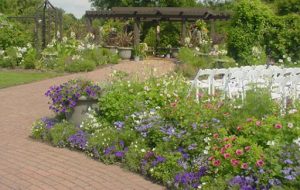Botanical gardens in southeast Wisconsin are some of the state’s best kept secrets. Whether you are looking for a way to identify new plants and get ideas for your landscape or just looking for a “daycation,” look no further than these islands of respite and beauty.
By definition, these public gardens are mission-based with specific plant collections. They are not just a rambling of plants collected over time (like my garden). They keep copious plant records and are open and accessible to the public. Their purpose is education, research, and display.
Within easy driving distance to Dodge County are several stellar Botanical Gardens, but space prevents me from doing them all justice. Here are five, in order of establishment:
Boerner Botanical Garden, just outside of Milwaukee in Hales Corners, is the oldest of the gardens. Founded in the 1930s with the purchase of land, the original work developing the park was done by the Civilian Conservation Corp (CCC) during the Great Depression. Today, more than 14 acres of gardens cover the 50-acre park. Admission is required and guided tours are available for groups larger than ten people. Visitors feast their eyes on dozens of themed gardens, blooming at different times of the year. Whether you want to see herbs, roses, peonies, annuals, rock gardens, or something unique Boerner has it all. In addition, there is an extensive trial garden where hundreds of different varieties of plants are the subjects of annual testing.

Olbrich Botanical Garden in Madison was established in the 1950s. This garden is free, although the Bolz Conservatory on the grounds has a nominal admission fee. With more than 14 acres of gardens, including a Japanese Courtyard, Thai Pavilion, Serenity Garden, meadow, rain, gravel, rose, and other traditional gardens, it is a destination well worth including in a day trip.
Rotary Botanical Garden, located in Janesville, was established in 1988 on a debris-filled sand and gravel pit. It is now an award-winning 20-acre park with over 25 garden areas. Admission is required to see this gem and guided tours are available. Japanese, French, Scottish, English, and Italian gardens, a children’s garden, and wellness gardens all await your visit. Annual and perennial plants as well as unique sculptures made from recycled (or “upcycled”) items make this garden a feast for the eyes.
Allen Centennial Gardens, dedicated in 1989, is the smallest of the gardens, located in the heart of Madison on the University of Wisconsin campus. This free garden is on a mere 2.5 acres, but still maintains more than 20 garden areas. With rock, woodland/shade, Japanese, meadow, pond, iris, English, and edible gardens to name a few, there is plenty to see.
Green Bay Botanical Garden opened in 1996. With about half of the 47 acres developed into 33 specialty gardens, lush woodland areas, and outstanding architectural highlights this garden has year-around events for everyone in the family. Admission is required and helps to support their ongoing and extensive programs.
There are more gardens for you to explore including the Paine Art Center and Gardens, Oshkosh, Bookworm Gardens, Oshkosh, Mitchell Park Horticultural Conservatory (The Domes), Milwaukee, and the Gardens of Kohler. Start planning to go and discover Wisconsin gardens this summer. Each of the gardens maintains a detailed website for more information.
Carol Shirk
Certified Master Gardener




